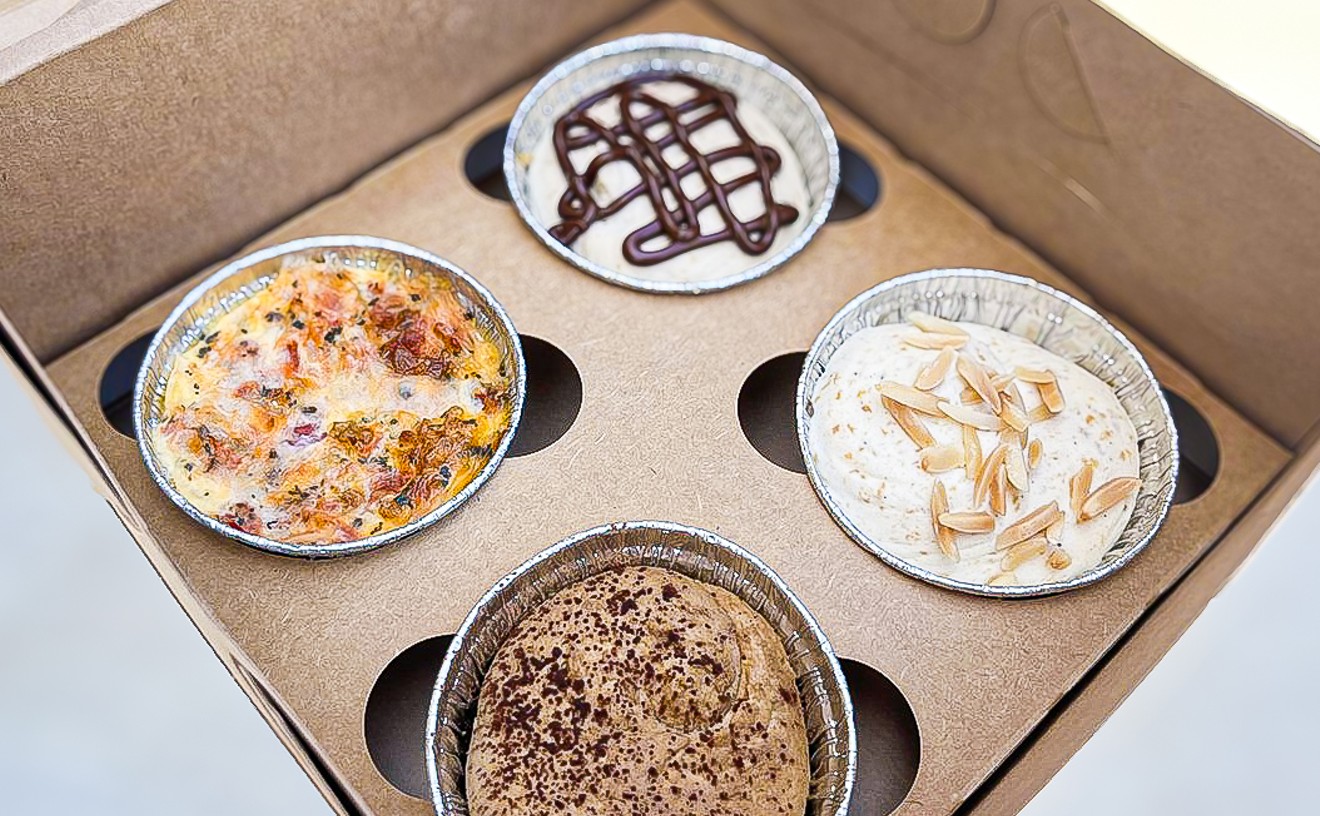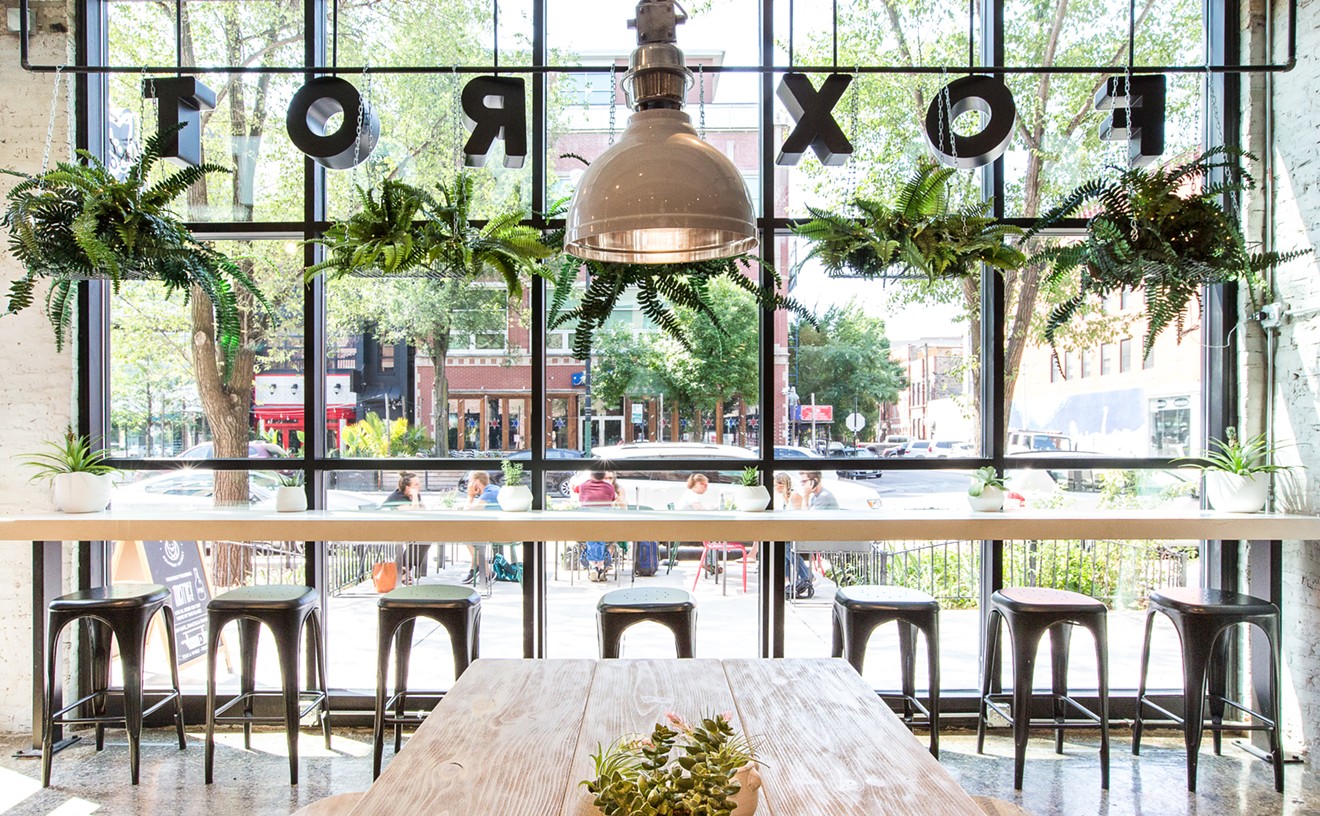There's a novel relationship between color and fruit swirling in Maher's head, one that has unexpected results on the plate. The young chef has clad the walls of his restaurant in impressionistic paintings from his personal collection, one he says he started building when he was a teen-ager. They burgeon with vibrant licks of color, a detail often obscured by the restaurant's dim lighting. "I look for color," Maher says. "I love paintings that speak to me through color."
He carries this lust to the saltwater fish tank imbedded in the wall at the back of the restaurant. Maher says he selected the fish, especially the yellow tang and the tomato clown fish, to blend with the surrounding paintings and the restaurant's papaya hue.
The vibrancy of these fruit tones is carried over into Maher's food, but not in ways you might think. Though educated at Le Cordon Bleu in Paris, Maher doesn't go much for butter and cream because he says the inherent fats blunt and obscure the intrinsic flavors he seeks to draw out. In their place he employs fruit, a substitution he says heightens the freshness of the food. Yet unlike the color in his art collection, Maher's food is not drenched in bracingly intense fruit colorings. Rather, his sauces are pervious cloaks that embrace rather than drape.
His quail breast is an apt example. Though engulfed in a busy rutabaga puree cranberry vinaigrette, the flavors of the bird (not at all livery, but moist and clean) easily slipped through. The sauce simply added a subtle spark that invigorated and balanced the flavors on the plate, which were broadened by brandy-flambéed golden raisins studding the sauce and a tangle of fried leeks crowning the bird breast.
Where Maher does employ cream, he does it with restraint. Pacific mussels came steeped in a broth of wine, chicken stock, garlic, shallots and just a touch of cream--enough to add a milky richness to the flavor, a barely perceptible viscid tackiness to the texture and a gauzy opaqueness to the aspect.
When Maher seeks to completely displace cream without sacrificing its body, the substitutions can get inventive. His sweet, delicate hamachi, secluded under an herb shroud of cilantro, parsley, sage, tarragon and chives, is bathed in a sauce rendered from roasted bell peppers, red onions and garlic flooded with coconut milk. But not just any coconut milk. Maher acquires a special coconut milk from Bangkok, one with a much higher fat content (20 percent) than most coconut milks sold in Dallas (13 to 14 percent). This would seem to run counter to Maher's philosophy, which stresses austere leanness when it comes to fats. Yet the structure of the coconut milk adds richness that enhances the sweetness of the fish rather than obscures, as animal fats might do.
Maher even plays tug-of-war with his preferences, pitting restrained richness against fruity briskness. His duck breast is sliced and glazed in bourbon and molasses. This seems like more than enough stress to heap upon a bird. But on top of that, Maher adds a kumquat-vanilla sauce. That's a lot of flavors to pile onto a flesh that has potent richness on its own. Yet this business somehow manages to merge without any collisions or struggles, though some of those slices were inordinately fatty. The meat was perched on a disc of crispy polenta, which skillfully magnified the earthy tones of the silky duck.
Maher's culinary path to Dallas and his own restaurant is riddled with just as many novel twists and turns as his food, though certainly not as subtle. He was born in Nicaragua, but he never lived in the Central American country because his parents were diplomats. He claims he lived in 36 countries growing up, often for no more than six months at a stretch.
The exception was the United States. He attended a military academy in North Carolina for high school and college in Texas at the University of Houston. His culinary training took him from Hokkaido, one of the four main islands of Japan, to Le Cordon Bleu in Paris and on to the Culinary Institute of America. He globe-hopped through a series of internships that included stints at the Mandalay Hotel in Jakarta, a stop in the city of Perth on Australia's West Coast and Buenos Aires. His last internship was in Reykjavik, Iceland, where he discovered the subtleties of Nordic cuisine. "I learned how to prepare salmon in many different ways," he says, laughing.
He ended up working with Houston chef Mark Cox and after that stint addressed an urge to work in a steak house. A steak house? "I wanted to work in a place that seated 600 people," Maher explains. "I wanted to master food at a very fast pace and still make it quality." So he worked at Pappas Bros. Steakhouse in Houston before coming to Dallas to work as a pastry chef at the Pappas Bros. installation here.
Then last fall Maher bought La Mirabelle from founders Francois and Catherine Fotre. He closed it and nipped and tucked it with all of that "papaya" before reopening the restaurant in February. He also changed the name to Mirabelle, jettisoning the "La," though in the thick glass panel separating the bar from the dining room the "La" is still visible. Maher says this is because he wants to maintain a thread of history in the restaurant to connect with its roots. He plans to change the name to Adrian's (after one of his children) before the end of the year.
Another of Maher's quirks is his shunning of olive oil. This is the culinary equivalent of blasphemy. Maher says he adheres to this track because the flavor is not neutral and it can obscure the natural flavors of his dishes, mainly seafood. Instead, he uses grapeseed oil, which has a relatively neutral flavor.
Yet what is one to make of the Mediterranean branzini? This Mediterranean sea bass was crusted in herbs--tarragon, sage, parsley and cilantro--and settled in a red wine emulsion on a bed of wild mushrooms. Our server says that Maher likes to create fish dishes that can work as well with red wine as they do with white. And the red wine emulsion with mushrooms certainly reaches out to lighter-bodied red wines. But there's hardly any thoroughfares here for natural flavors to shine through. Though the fish was delicate and sweet, it didn't flake and was a little spongy.
Perhaps in a twist from his steak house stint, Maher offers a grilled buffalo medallion that's smeared with a merlot sauce and capped with a single morel mushroom. Despite its lush appearance and burnt-orange hue, this wasn't an in-your-face sauce, but a delicately pervious one that let the rich, lean flavors of the buffalo meat peek through.
But Maher's Hawaiian king prawns are perhaps the best example of what he is trying to achieve in the kitchen. Though the head-on prawns are bathed in an orange beurre blanc with a little Chablis, the meat tastes like a fresh spritz of ocean spray. And despite sauce fats, there was no obscuring of these flavors. This is a rare flavor profile to stumble across in a landlocked restaurant.
Passion fruit crème brûlée was typical of its ilk. The lid was crisp and warm, the custard was cool and firm, and the taste of passion fruit was suffused throughout.
Service at Mirabelle is excellent, with servers who are well-versed in the ingredients of the dishes and attuned to the flavor profiles on the wine list (mostly French and California examples). Servers know the menu and the ingredients and know the flavors of many of the wines and what they would be most successfully paired with.
Maher says he thinks of his food as art. There is certainly nothing revolutionary in this conjecture. Yet Maher tumbles a little with this cliché by using oversized tableware of varying colors and styles to "frame" his food. Sometimes it seems Maher's food disappears in these frames. Yet this is just a subtle deception, for it comes across on the tongue with the impassioned vibrancy of his art collection.










